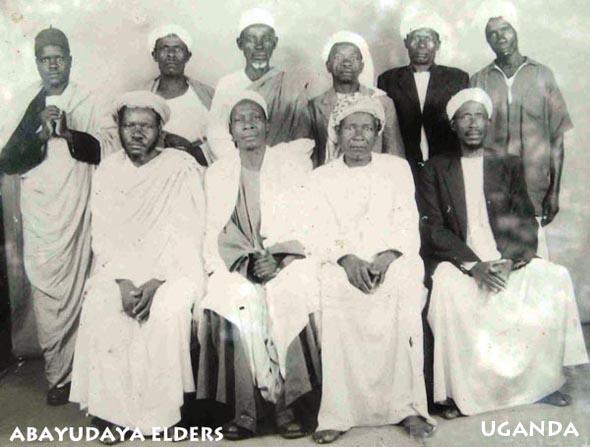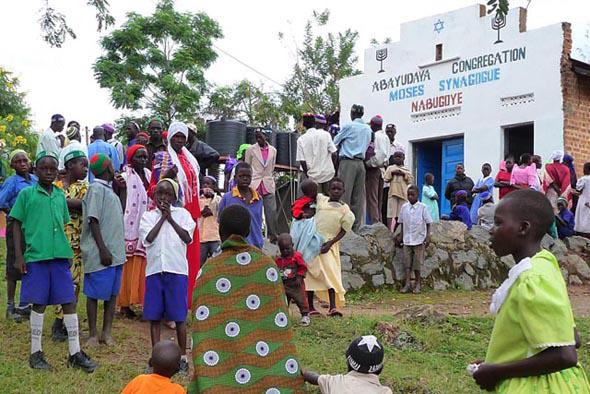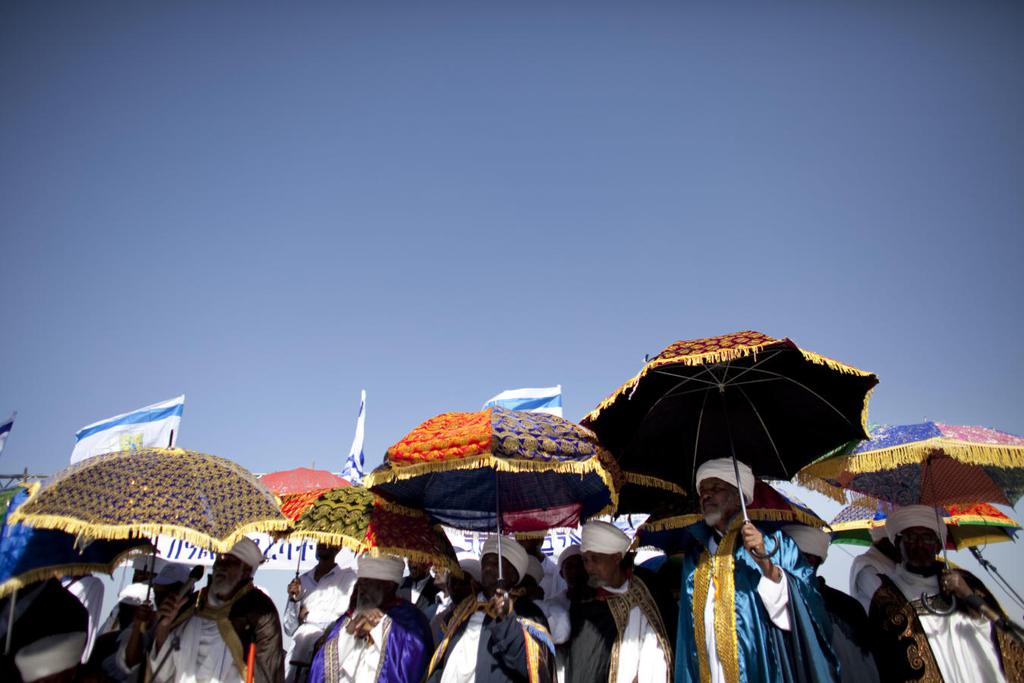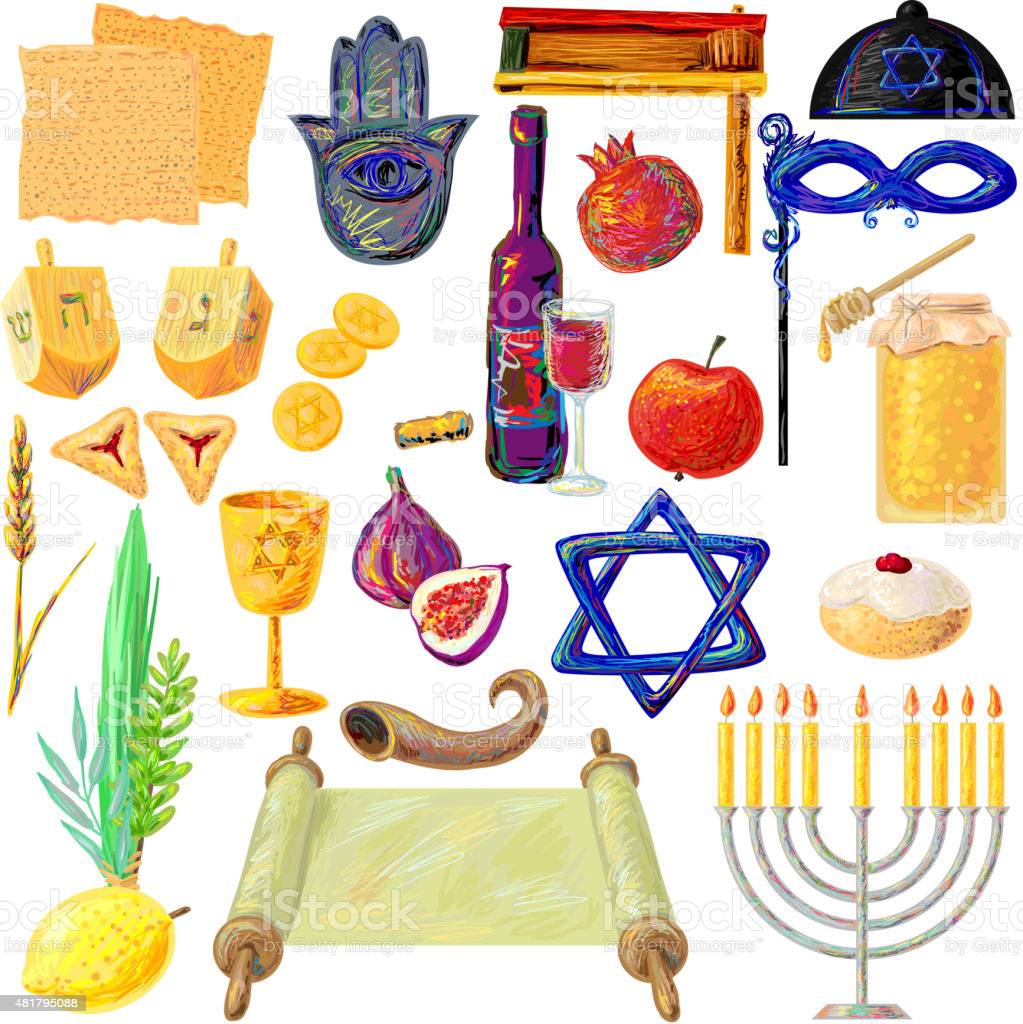Sigd “on one foot”:
Sigd is a holiday celebrated by the Ethiopian Jewish community 50 days after Yom Kippur.
There are Jews in (Sub-Saharan) Africa?
Lemba
- Tribe in Zimbabwe
- The Y chromosomes of the Buba clan have the same genetic markers as Cohanim
- Don’t marry non-Lemba
- Claim origin from Senna on the Southern Arabian peninsula, an area known to have Jews in it.
- Observe a day of rest
- Don’t eat pigs or other animals forbidden by the Torah
- Ritually circumcise males
- Only eat meat ritually slaughtered by Lemba (ritual slaughter is not an African practice but it is a Middle Eastern practice)
- Women who marry Lemba men must follow Lemba religious and dietary practice and children must be raised as Lemba
https://www.jewishvirtuallibrary.org/lemba; https://en.wikipedia.org/wiki/Lemba_people
Abayudaya
- In Uganda
- In 1919 Semei Kakungulu was asked to be a Christian missionary by the British, but he favored the Old Testament and led his community to embrace Judaism.
- In 1971 Idi Amin came to power in Uganda and forbid the practice of Judaism. Many in the community were forced to convert to other religions.
- In 1979 Amin fell from power and the Jewish community began to rebuild.
- In the 1980s, Gershom Sizomu, the grandson of community elder “Rabbi” Samson, leads the youth of the community in building the Moses Synagogue.
- In 2002 the Abayudaya reach out to 4 Conservative rabbis in the US and 1 in Israel to formally convert the community as well as to build bridges with the rest of world Jewry.
- In 2008 Gershom Sizomu completes rabbinical school at Ziegler in Los Angeles and is ordained in Uganda. Be’chol Lashon, an organization dedicated to helping Jewish communities around the world, provides funding.
- In 2016 Rabbi Gershom Sizomu wins a seat in the Ugandan Parliament. The work that the Abayuda do to provide medical care to the Christians and Muslims in the area help build goodwill for both the community and for Gershom.
- In 2017 the Jewish Agency for Israel formally recognizes the Abayudaya as Jews.
- In 2019 the community celebrates 100 years as a Jewish community.
https://globaljews.org/explore/abayudaya/history/
Abayudaya Charoset
- Peanuts or cashews
- Honey
- Bananas
- Apples
- Sweet wine
From Koshersoul, by Michael Twitty, 2022 (p. 349)


Photos from the early 20th and then early 21st centuries.
Photo credit to Be’chol Lashon: https://globaljews.org/explore/abayudaya/history/
This is the Debbie Friedman tune for Havdalah being sung by the Abayudaya at the close of Shabbat.
“Ameh Yisrael Chai” was written by Noam Katz. Here is his own words from a Facebook correspondence:
I met one of the elders of the Abayudaya community, JJ Keki, in Boston in 2001. After an evening of JJ sharing the history and music of his community, I went home and was inspired to write that version of Am Yisrael Chai with the Ugandan rhythms still swimming in my head. Two years later, I went to Uganda on a volunteer mission for 3 months, living and working with the community, and wrote more music inspired by them, which led to the recording of my second album, “Mirembe, Salaam v’Shalom”. But the Am Yisrael Chai was already fairly well known in the States as I had shared it at Kutz, URJ Biennial , Hava Nashira, and Craig Taubman used it regularly at his Friday Night Live in LA. The official recording - with JJ on guest vocals - came out in 2005.
South Africa
- Jewish explorers, cartographers, and astronomers helped the Portuguese round South Africa in the 1400s.
- In 1669 the first Jews move to the Dutch colony in South Africa
- In 1841 the first synagogue is founded in South Africa (now under British control since 1805)
- In 1856 Julius, Adolf, and James Mosenthal start the mohair industry.
- Between 1880 and 1914 the Jewish population swells from 4,000 to 40,000, mostly from Lithuania.
- Jews fight in the Second Boer War on both sides - 2,800 for the British, 300 for the Boers.
- Between 1933 and 1939 6,500 German Jews emigrate to South Africa; in 1937 the Alien Act severely cuts that down
- During WWII many Afrikaners (descendants from the Dutch) are pro-Nazi because they don’t like the British
- Post-WWII many Zionist South Africans make aliyah to Israel
- In 1980 the Jewish Board of Deputies of South Africa issues a resolution against apartheid, and in 1987 Israel imposes sanctions.
- In 1986 Irwin Cotler represents Nelson Mandela in his trial
- As of 2021 about 80,000 Jews live in South Africa, making it the largest Jewish community in Africa
https://en.wikipedia.org/wiki/History_of_the_Jews_in_South_Africa; https://www.jta.org/2013/12/05/culture/from-the-archive-nelson-mandela-and-the-jews
Resources on Other Jewish Communities in Sub-Saharan Africa
- Cameroon - https://kulanu.org/communities/cameroon/, http://www.africanjewishcommunities.net/articles.php?lng=en&pg=14, https://www.jewishvirtuallibrary.org/cameroon-virtual-jewish-history-tour, http://jewswerehere.com/africa/westafrica/cameroon/, http://haruth.com/jw/JewsCameroon.htm
- Cote D’Ivoire (Ivory Coast) - https://kulanu.org/communities/cote-divoire/, http://jewswerehere.com/africa/westafrica/cote-divoire/,
- Congo - https://kulanu.org/communities/democratic-republic-of-the-congo/, https://www.jewishvirtuallibrary.org/democratic-republic-of-congo-zaire-virtual-jewish-history-tour, http://jewswerehere.com/africa/midafrica/drc/,
- Gabon - https://kulanu.org/communities/Gabon/, http://jewswerehere.com/africa/midafrica/gabon/,
- Ghana (including Sefwi Wiawso) - https://kulanu.org/communities/ghana/visit-jewish-community-sefwi-wiawso-ghana/, https://kulanu.org/communities/ghana/, http://www.africanjewishcommunities.net/articles.php?lng=en&pg=18, https://www.jewishvirtuallibrary.org/ghana-virtual-jewish-history-tour, http://jewswerehere.com/africa/westafrica/ghana/, http://haruth.com/jw/JewsGhana.html,
- Kenya - https://kulanu.org/communities/kenya/, https://www.jewishvirtuallibrary.org/kenya-virtual-jewish-history-tour, http://jewswerehere.com/africa/eastafrica/kenya/, http://haruth.com/jw/JewsKenya.htm,
- Madagascar - https://kulanu.org/communities/madagascar/, https://www.jewishvirtuallibrary.org/madagascar-virtual-jewish-history-tour, http://jewswerehere.com/africa/eastafrica/madagascar/,
- Nigeria - https://kulanu.org/communities/nigeria/, http://www.africanjewishcommunities.net/articles.php?lng=en&pg=11, https://www.jewishvirtuallibrary.org/nigeria-virtual-jewish-history-tour, http://jewswerehere.com/africa/westafrica/nigeria/, http://www.haruth.com/jw/JewsNigeria.htm,
- Tanzania - https://kulanu.org/communities/tanzania/, http://jewswerehere.com/africa/eastafrica/tanzania/,
- Other communities can be found here: https://www.jewishvirtuallibrary.org/africa-virtual-jewish-history-tour, http://jewswerehere.com, http://haruth.com/jw/
What about the Jews in Ethiopia?
Beta Yisrael (Ethiopian Jews)
- Many ideas of where they came from:
- The lost tribe of Dan (from when the Assyrians deported the 10 northern tribes in 722 BCE) (based on account from 850 CE of Eldad Ha-Dani, who claimed to be from the tribe of Dan now living in Ethiopia)
- The descendants of Menelik I, supposedly the son of King Solomon and the Queen of Sheba (around 1000 BCE)
- The descendants of Ethiopian Christians and pagans who converted centuries ago
- The descendants of Jews who went to Egypt after the first Temple was destroyed in 586 BCE
- They lived at peace with their neighbors until the late 1200s, when the Solomonic Dynasty came to power and sought to expand their territory by conquering the Beta Israel
- In the 1500s, the Radbaz (Rabbi David ben Solomon ibn Avi Zimra), the chief rabbi of Egypt, said that the Beta Israel were Jews according to Jewish law.
- In 1624 they had their last battle for independence in what has been described as their Masada
- In 1769, Scottish explorer James Bruce found them while searching for the source of the Nile. He estimated their number to be at 100,000, down from 500,000 a few centuries before.
- In 1855, the first Beta Israel, Daniel ben Hamdya, visits Jerusalem and makes the case for recognizing the Jewishness of Beta Israel. Over the next 53 years, the chief rabbis of 45 countries make this recognition.
- In 1947, Ethiopia abstains in the vote on the Partition Plan.
- In 1955, the Jewish Agency for Israel helped construct schools and a teacher’s college for the Beta Israel
- In 1956, Israel and Ethiopia established diplomatic relations until the 1973 Yom Kippur War.
- In 1972, Rabbi Ovadia Yosef, chief Sephardic rabbi of Israel, says that they are Jews according to Jewish law
- In 1974, Colonel Mengistu took power and forced peasants from other places to live in Beta Israel villages, increasing anti-Semitism in the Gondor region.
- In 1975, Rabbi Shlomo Goren, chief Ashkenazic rabbi of Israel, says that they are Jews according to Jewish law
- In 1977, a set of attempts to bring the Ethiopian Jews to Israel begins:
- In 1977, due to anti-Semitism, Israel trades planes of military supplies for taking out 200 Beta Israel on the empty return flights.
- Between 1981 and 1984, due to outlawing Judaism and forced conscription of boys at age 12, the Mossad ran a real Red Sea diving resort that also smuggled out 12,000 Beta Israel by boat to Israel (Operation Brothers)
- In 1984, due to famines in Ethiopia and Sudan, Israel airlifted 8,000 Beta Israel out of Sudanese refugee camps to which they had walked (Operation Moses)
- In 1985, due to many being left behind when Operation Moses was forced to end, Israel airlifted another 500 Beta Israel out of Sudan (Operation Joshua).
- In 1991, due to civil war in Ethiopia, Israel airlifted 15,000 Beta Israel over 36 hours from Ethiopia (Operation Solomon)
- In 2012, due to the discovery of more previously unknown Jews in Ethiopia, Israel airlifted another 8,000 from Ethiopia (Operation Dove’s Wings)
- Airlifts were done with C130 Hercules planes (the sort one flies tanks in) and El Al's Boeing 747s with the seats taken out. While the planes were new for most Ethiopians, they connected them to G-d's promise to bring the people on the wings of eagles (Ex. 19:4).
- Much work was also done to help absorb the new immigrants into Israeli society, as well as acclimating them to modern conveniences.
- There has been some racism against Ethiopians (and other dark-skinned people in Israeli society.
https://www.jewishvirtuallibrary.org/ethiopia-virtual-jewish-tour
A reading of a story that tells one girl’s journey from Ethiopia to Israel. The book is Yuvi’s Candy Tree, written by Leslie Simpson (and based on a true story).
Meet Yuvi!
Context: This song, “Falasha Nevermore”, was written by the Jewish-American rock group Safam in 1986. This was shortly after the airlifts of Ethiopian Jews to Israel during Operations Moses and Joshua (Operation Solomon happened in 1991). “Falasha” was a derogatory term for the Beta Israel, meaning “stranger”.
Today, you can click a few buttons on the computer to book a flight and a hotel, and 36 hours later you can be in Israel. This contrasts with the journey of the Ethiopian Jews, as told in this heartbreaking song sung by Eden Alene. (Kippah tip to Miron Hirsch)
What is Sigd?
- Because the Beta Israel lived in isolation from rest of Jewish world for centuries, they developed some different customs including Sigd (sihgd)
- “Sigd” is an Amharic word meaning “prostration” or “worship” (related to “Sged”, Aramaic for prostration)
- Also sometimes called “Mahlele”, meaning “praise” (related to “Halleluya”)
When Is Sigd?
- The date is the 29th of Cheshvan, 50 days after Yom Kippur (similar to Shavuot)
- Timing is for people to actually put their resolutions into practice and get along better with each other, and then celebrating reconciliation with communal gathering
- The date G-d revealed G-d’sself to Moses, according to Ethiopian Jewish tradition
What is Sigd about?
- Themes:
- Accepting Torah (Mt. Sinai and under Ezra, when the Jews returning from exile in Babylonia recommitted themselves to Jewish practice under the religious leadership of Ezra and the political leadership of Nehemiah)
- Yearning for the Temple
- Time for renewing covenant with G-d
- Focus also on unity of Ethiopian Jewish community as well as the broader Jewish community, and thinking about the centrality of Israel as the Jewish homeland
- Reminder also about the importance of Jewish tradition, even in exile
When did Sigd start?
- Dates back to 500s during the time of King Gebre Mesqel of Axum, when the war between the Jewish and Christian communities ended and the communities separated
- Or perhaps dates back to the 1400s during the time of persecution by Christian emperors. Goal was to unify Beta Yisrael and keep them from abandoning traditions under pressure.
- Modeled after reacceptance of the tradition during time of Nehemiah.
- First mention is in the 1400s.
What happens during Sigd?
- Fast during the morning
- Walk to the top of mountain (usually in Ambober, about a 400 mile walk by foot from Gondor, yet thousands of Jews made the trip each year - possibly a site of relief from persecution).
- Similar to getting Torah at top of Mt. Sinai
- Before getting to the mountain, ritually immerse in a river and put on clean holiday clothing
- Kessim (spiritual leaders) carry “Orit” (from “Oraita”, the Aramaic word for “Torah”), the Ethiopian Torah (also containing Joshua, Judges, and Ruth) written in Ge’ez (liturgical language)
- Kessim recite selections including from Nehemiah (also from Leviticus and Deut)
- Community has prayer service, including prostration on the ground and asking forgiveness for their sins. Shofar blown, and say “Just as we have merited celebrating this holiday this year, may we merit to celebrate it next year in Jerusalem”.
- Others talk about desire to go to Jerusalem
- In afternoon return to homes to break fast (sort of like a seder), dance, and celebrate
- The greeting is “Melkam sigid Beal”, which means “Happy Sigd!”
How is it celebrated in Israel?
- State holiday since 2008, under Uri Ariel’s bill - going to work is optional, and it is taught in schools now
- In Israel celebrate on Mt. Zion and also on Armon Hanatziv Promenade in Jerusalem, with procession to Western Wall either way
- Fast, recite psalms, and Kessamim read from the Orit, then break fast, dance, and celebrate
- Israeli president also holds a celebration at their residence attended by dignitaries and Ethiopian Jews

During Sigd, the kessim (priests) are shaded by colorful umbrellas. This holiday tradition was brought to Israel.
Photo credit: MyJewishLearning - https://www.myjewishlearning.com/article/when-is-sigd-2021/
A short video from the Israeli government press office about Sigd.
A short video from an Ethiopian newspaper.
A long video about Sigd and Ethiopian Jewish culture, showing a Friday evening experience. It is put together by Be’chol Lashon, which helps Jewish communities around the world.
One Ethiopian Jew’s Sigd Experience
With every Jewish holiday in the US, it is difficult to feel the same amazing feeling you get from celebrating it in Israel. The same goes for me with the upcoming holiday of Sigd, which falls on November 11 this year. From a young age, I remember going to Jerusalem each year, to Armon HaNatziv, to join thousands of Beita Yisrael Ethiopian Jews to mark the holiday in holy and spiritual splendor.
During Sigd, thousands listen to prayers led by the Kessim (Ethiopian clergy), responding “Amen,” then standing for several hours in prayer recalling the revelation at Mount Sinai, the establishment of the covenant and the reaffirmation of the bond between God and his people during the days of Ezra the Scribe.
The atmosphere of that day always energized my spiritual essence. Fifty days after Yom Kippur, after we had already stood before God, here we were yet again, but this time in order to renew our covenant.
Sigd, which means “bowing down,” is extremely important in the tradition of the Ethiopian-Jewish community because it symbolized, for us, the yearnings we felt for Jerusalem. In Ethiopia it is celebrated by going up a large mountain, facing Jerusalem, fasting for half of the day to recall the destruction of the Temple and then ending the fast during the second half of the day with singing, dancing and a festive meal to celebrate our covenant with God.
We continue to celebrate Sigd in Israel because in the eyes of many of the older members of the Ethiopian community, the return to Zion has not yet been completed. Although the last group of Ethiopian Jews landed in Israel in 2013, there are still many Jews all over the world who belong in Israel. Moreover, since the third Temple has not yet been built, the Jerusalem we long for when we sing “Next Year in the Rebuilt Jerusalem” is still only a prayer.
In Ethiopia, Sigd was also an opportunity to strengthen and reinforce the community, a chance for distant families to come together for a great community-wide celebration attended by young and old alike. This experience continues in Israel. Many mothers bring loaves of Ethiopian challah to the prayer ceremony. At the end, they share their challah on the promenade in Armon HaNatziv and then return home for a family or neighborhood meal.
On June 30, 2008, the Knesset passed the Sigd Festival Law, which was set according to its Hebrew date of 29 Heshvan and calling for schools and educational institutions to mark the holiday with social and educational activities. Celebration of the holiday in the educational system aims to reinforce the relationship between Ethiopians and their heritage and gives a place of honor to the cultural treasures that Ethiopian Jews brought with them.
For me, the Sigd Festival Law also enables public institutions, especially in Israel, to abandon the assimilationist concept of the “melting pot” and to adopt a multicultural and pluralistic approach of accepting “the other” and those from different cultural backgrounds in our country. It represents the integration of traditions from different Jewish communities into the Jewish calendar, proof that it is indeed possible to include everyone.
- Penina Gaday Agenyahu
https://jewishfoodexperience.com/ethiopian-community-comes-together-for-sigd/
Recipe for Kik Alicha (Ethiopian Dish)
Recipe contributed by Liora Samuel. This is one of the most common accompaniments to Ethiopian injera. The key is to cook the peas until they are tender, but still hold their shape. Another variation of this dish uses fresh green beans, sliced in half, cooked separately in less water until soft and then combined with the sautéed onions, garlic, tomato and spices.
Ingredients
- 2 tablespoons soybean or vegetable oil
- 2 large cloves garlic, crushed
- 1 onion, finely diced
- Pinch each of black pepper, white pepper, chili pepper, salt, ginger, cumin
- 1 tomato, quartered
- 1 pound dried yellow split peas or dried green lentils
- 5-6 cups water
Preparation
Heat oil in a large pot. When hot, add garlic and onion, stirring until golden and fragrant. Add spices and tomato and cook until combined and tomato is soft, about 15 minutes. Add peas and water to pot and simmer until peas are soft, but not mushy, about 45 minutes to 1 hour. It should be stew-like in consistency. Serve with—or on—the traditional flatbread, injera.
https://jewishfoodexperience.com/recipes/kik-alicha-split-pea-sauce-injera/
From Bezawit Abebe: This song speaks directly about the longing for Jerusalem and the return to Zion; the holy city with the pure light. Some parts of the song like the line that says ‘selam Leki’ are written in Ge’ez. The singer is Grammy nominated Gili Yalo, an Ethiopian Israeli musician who embodies his own personal story, which inspired the rhythm and flow of his work.
And what a story he has to tell: during Operation Moses, the covert evacuation of Ethiopian Jews from Sudan during a famine in 1984, Yalo and his family made the perilous journey from their native land by food. The vision of getting to the “Promised Land” sustained them and throughout the adjurous trip they sang to inspire themselves and give them courage. In the course of this exhausting and emotional journey, the music encouraged Gili Yalo and his family to keep on moving.
Here are the words for his version of this traditional Ethiopian Jewish song and my translation. Note that the word Salem is the final syllable of the word Jerusalem and appears in this song as a shorthand for Jerusalem.
Salem
Your face is In a pure light,
the holy city of Zion
Hello to you, our city
Peace, may peace be upon you
Immigrant migrant
Peace, may peace be upon you
May peace be upon the Temple
Like a big light on your face …
Hello hello hello to you
Jerusalem Salem
Hello hello hello to you
The Temple of peace
Peace, may peace be upon you
Immigrant migrant
Salem Salem Leki
כְּמוֹ אוֹר גָּדוֹל פָּנַיִךְ עִיר צִיּוֹן הַקְּדוֹשָׁה
שָׁלוֹם לָךְ עִיר
בְּתוֹך אוֹר טָהוֹר פָּנַיִךְ עִיר צִיּוֹן הַקְּדוֹשָׁה
שָׁלוֹם לָךְ עִיר
בְּתוֹך אוֹר גָּדוֹל פָּנַיִךְ עִיר צִיּוֹן הַקְּדוֹשָׁה
שָׁלוֹם לָךְ עִיר
כְּמוֹ אוֹר טָהוֹר פָּנַיִךְ עִיר צִיּוֹן הַקְּדוֹשָׁה
שָׁלוֹם לָךְ עִיר
בְּתוֹך אוֹר טָהוֹר פָּנַיִךְ עִיר צִיּוֹן הַקְּדוֹשָׁה
שָׁלוֹם לָךְ עִיר
כְּמוֹ אוֹר גָּדוֹל פָּנַיִךְ עִיר צִיּוֹן הַקְּדוֹשָׁה
שָׁלוֹם לָךְ עִיר
כְּמוֹ אוֹר טָהוֹר פָּנַיִךְ עִיר צִיּוֹן הַקְּדוֹשָׁה
שָׁלוֹם לָךְ עִיר
כְּמוֹ אוֹר גָּדוֹל פָּנַיִךְ עִיר צִיּוֹן הַקְּדוֹשָׁה
שָׁלוֹם לָךְ עִיר
סֶלַם סֶלַם לֶקִי
סֶלַם סֶלַם לֶקִי
סֶלַם סֶלַם לֶקִי
הָגֶר אַבְּהָוֶוינָה
סֶלַם סֶלַם לֶקִי
סֶלַם סֶלַם לֶקִי
סֶלַם סֶלַם לֶקִי
בֵּית מִִקְדּסוֹ סֶלַם
כְּמוֹ אוֹר גָּדוֹל פָּנַיִךְ…
שָׁלוֹם שָׁלוֹם שָׁלוֹם לָךְ
שָׁלוֹם שָׁלוֹם שָׁלוֹם לָךְ
שָׁלוֹם שָׁלוֹם שָׁלוֹם לָךְ
יְרוּסָלַם סֶלַם
שָׁלוֹם שָׁלוֹם שָׁלוֹם לָךְ
שָׁלוֹם שָׁלוֹם שָׁלוֹם לָךְ
שָׁלוֹם שָׁלוֹם שָׁלוֹם לָךְ
בֵּית מִקְדָּסוֹ סֶלַם
סֶלַם סֶלַם לֶקִי
סֶלַם סֶלַם לֶקִי
סֶלַם סֶלַם לֶקִי
הָגֶר אַבְּהָוֶוינָה
סֶלַם סֶלַם לֶקִי
סֶלַם סֶלַם לֶקִי
אֶרֶץ אֲֲבוֹתֵינו
סֶלַם סֶלַמֶה סֶלַמֶה
K’mo or gadol panaich ir tzion hakedosha
Shalom lach ir
B’toch or tahor panaich ir tzion hakedosha
Shalom lach ir
B’toch or gadol panaich ir tzion hakedosha
Shalom lach ir
K’mo or tahor panaich ir tzion hakedosha
Shalom lach ir
B’toch or gadol panaich ir tzion hakedosha
Shalom lach ir
K’mo or gadol panaich ir tzion hakedosha
Shalom lach ir
K’mo or tahor panaich ir tzion hakedosha
Shalom lach ir
K’mo or gadol panaich ir tzion hakedosha
Shalom lach ir
Selam selam leki
Selam selam leki
Selam selam leki
Hagar abhavavna
Selam salam leki
Selam selam leki
Selam selam leki
Beit Mekdiso selam
K’mo or …
Selam selam leki
Selam selam leki
Selam selam leki
Hagar abhavavna
Selam salam leki
Selam selam leki
Selam selam leki
Eretz Avoteinu
Selam selmeh selmeh
https://globaljews.org/jewishand/amharic-song-for-sigd/
With appreciation to: MyJewishLearning, Jewish Virtual Library, The Jewish Agency for Israel, Moishe House, Wikipedia, Kveller, Be’chol Lashon, and Kulanu.





